Processor Modules for Embedded Control and Connectivity Solutions
投稿人:电子产品
2013-12-04
Even though MCUs continue to expand in logical and functional density, the performance and feature requirements of today’s designs are such that it is often difficult to provide a monolithic solution. As a result, the embedded processor is in many cases actually morphing into a module integrating the processor, RAM, Flash memory, and even a power supply along with other supporting discrete components. A design trend that began with processors inside a typical PC (processor modules started replacing the single-chip solution back in the Pentium II days) has now fully emerged in the embedded space as the required amount of functionality, and dictates that selecting a module can be the best course of action to effectively and efficiently implement a design on time.
This article examines available off-the-shelf modules that encapsulate individual functions as well as entire system-processing capabilities. All parts, datasheets, tutorials, reference designs, and development kits referenced are available online at DigiKey’s website.
Modular means replaceable
Although many simple functions can be reduced to basic logical functions, designing with discrete logic chips may not be the best approach, especially during the developmental phase where test and observation often means changing the logic or tweaking it a bit. Because of this, a programmable solution is the fastest answer since changes in logical function can take place without lifting a soldering iron.
Based on the Microchip PIC16C56a, the BS1-IC Basic Stamp module from Parallax is worth a close look (Figure 1). A simple SIP in-line socket on your carrier board couples power and signals to a small, programmable processor module. This is a 4 MHz micro module that runs very-small and limited basic programs using the PIC processor, providing eight I/O pins and up to 80 instructions in a program with only 16 bytes of RAM.
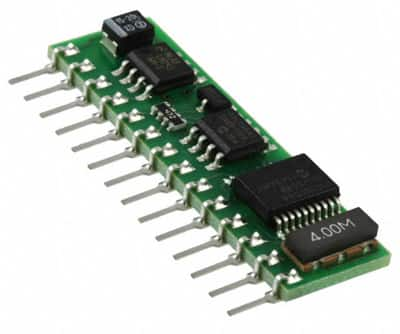
In some cases, the reason for modularity is to upgrade ability, a very easy thing to accommodate when processor modules come in standard, scalable packages. Parallax also offers the 20 MHz BS2-1C module based on the Microchip PIC16C57c module in a 24-pin DIN package with 16 bits of I/O and serial (up to 9,600 baud) ports with up to 500 instruction programs. In this package, scalable BS2-IC and BS2sx-ICs are available, the latter with a Parallax 8-bit MCU operating at up to 50 MHz, offering a bit more performance and I/O, but still limited to fairly-simple tasks.
Rabbit season
Moving up the food chain are the Rabbit Semiconductor Processor Modules that integrate some higher-level peripherals and functions like Ethernet-based functionality along with C programmability. Take, for instance, the Rabbit 20-101-1306 (core module RCM5750). This 50 MHz processor module has edge-connect fingers for easy insertion and removal, 1 Mbyte of Flash, and 128 Kbytes of RAM. It also allows programming in C with APIs for access to the on-board peripherals including up to 35 I/O lines, six serial ports (some with SPI and HDLC functionality), RTC, as well as an Ethernet port. A reference design shows an integrated Ethernet port for network connectivity, with royalty-free TCP/IP software.
Rabbit Semiconductor’s RCM5700 and RCM6700 series devices are compact modules in a mini PCI Express form-factor. They incorporate the Rabbit 5000 and 6000 processors with integrated 10/100Base-T Ethernet functionality and on-chip SRAM. The devices include hardware DMA, I/O lines shared with up to six serial ports, and four levels of alternate pin functions that include variable-phase PWM, an external I/O bus, quadrature decoder, and input capture.
Zilog’s EZ80L925048MODG module (Figure 2) offers a similar royalty-free TCP/IP stack and OS processor module with Ethernet that adds web-serving capabilities. A compact, high-performance Ethernet module specially designed for the rapid development and deployment of embedded systems requiring control and Internet/Intranet connectivity, this expandable module is powered by Zilog’s eZ80L92 device, a member of Zilog’s eZ80 Acclaim family. The 48 MHz processor also has an IRDA port, two UARTs, one SPI, one IIC port and RTC, 1 Mbyte of Flash, and 512 Kbytes of RAM for program and scratch. Two 50-pin headers allow quick-and-easy insertion and removal to your motherboard as well. A Product Training Module for the company’s ez80 Acclaim Family can be found on DigiKey’s website.
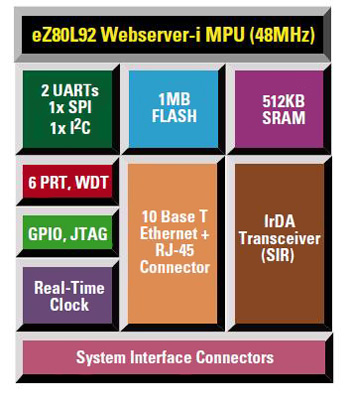
In the same class is the MOD5272-1001R from NetBurner. Based around a 32-bit Freescale ColdFire 5272 running at 62.5 MHz with 8 Mbytes of SDRAM and 2 Mbytes of Flash, this module has 10/100-Mbit/s Ethernet, two UARTs, and SD/MMC Flash-card support (Figure 3).
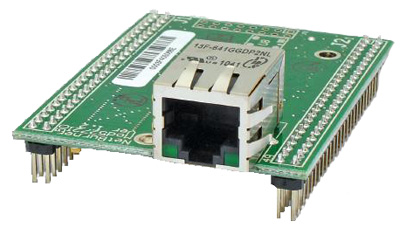
Using C and C++ as the gateway into development, the system software includes the TCP/IP stack and real-time OS support, web server, FTP server, and e-mail support. There are many more programming resources as well with the 8 Mbytes of SDRAM and 2 Mbytes of Flash. Like the Zilog module, 50-pin DIN headers allow easy insertion and removal, as well as scalable upgrade ability.
Bigger performance in a smaller package
Anything that will connect to a wired Ethernet port will need an RJ45 connector on board. What if the RJ45 connector was the board, and had the processor embedded within it? That is what Digi-International has done with the DC-ME-Y401-JT and its ARM® core (Figure 4).
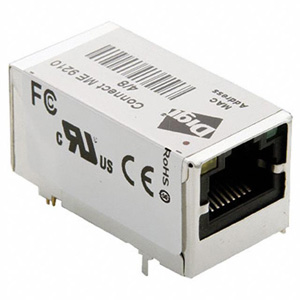
Based on Digi’s NS9210 processor with the ARM926EJ-S core, the 2 Mbit wave-solderable, 75 MHz module-in-a-connector also has a CAN interface in addition to the 10/100 Ethernet, UARTs, IIC, and SPI ports and an AES 256-bit encryption block. A 4-Mbit version, DC-ME-Y402-JT, is also available for more program space.
Several other manufacturers have also embraced ARM core modules, and a variety of performance and functional capabilities are supported under the ARM umbrella including dual-core parts and those with DSP companions. Take, for instance, the SOMDM3730-20-2780AGCR Torpedo system-on-module from Logic PD. These use low-profile, high-density, board-to-board connectors to provide a fairly-high amount of processing power in a small space (Figure 5). Logic PD’s Torpedo System-on-Module (SOM) series use a compact form-factor based on the Texas Instruments DaVinci DM3730 Digital Media processor and Sitara AM3703 processor. The DM3730 Torpedo SOM occupies less than one square inch, but boasts speeds of up to 1 GHz.
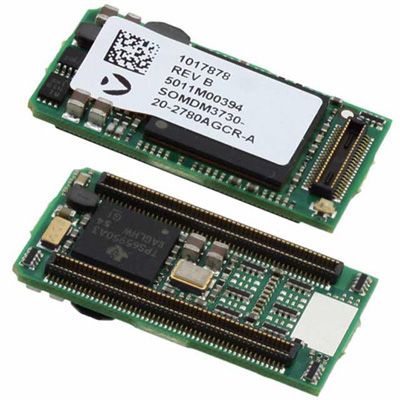
These are higher-end 1 GHz ARM Cortex™-A8 processor modules that feature a TMS320C64 DSP coprocessor alongside to offload computationally-intense and DSP-related functions. This leaves the ARM core to do RTOS and communications-based functions.
Another dual-core module with DSP hooks comes from Bluetechnix with its eCM-BF561 Core Module (100-1214-1). This core is optimized for parallel-processing applications and is centered around two Analog Devices Blackfin-based ADSP-BF561 processors, each running at 600 MHz. With 128 Mbytes of RAM and 32 Mbytes of Flash, these processors target demanding applications like real-time video processing, facial recognition, and gesture decoding.
Summary
Fully-functional and integrated processor modules serve as a good way to quickly and easily get a concept into a functioning real-world machine. A lot of time can be saved when starting with a complete debugged processor and the necessary software stacks. With performance and features ranging from simple logic replacement to high-end dual- and multi-processor MCU and DSP systems, these modules can serve as development platforms and can be cost effective enough to use in OEM designs.
For more information on the parts discussed in this article, use the links provided to access product pages on the DigiKey website.
免责声明:各个作者和/或论坛参与者在本网站发表的观点、看法和意见不代表 DigiKey 的观点、看法和意见,也不代表 DigiKey 官方政策。








